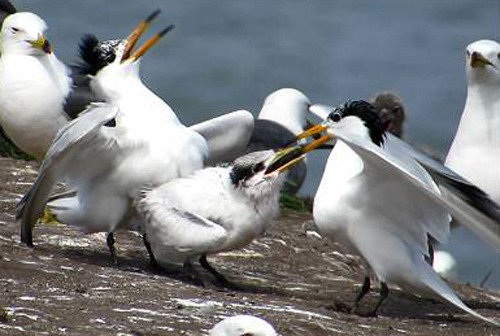Endangered Chinese crested terns appear on a deserted island in southern coast
Endangered Chinese crested terns appear on a deserted island in southern coast
Posted August. 08, 2016 06:54,
Updated August. 08, 2016 07:27

The Ministry of Environment and the National Institute of Ecology (NIE) confirmed on Sunday that five Chinese crested tern mother birds were found to have been inhabiting in a deserted island in South Jeolla Province.
According to the ecology institute, Chinese crested terns are one of the rarest animals, with an estimated population of not more than 100 individuals left on earth. The tern is even called as a "mythical bird," as it remained in the shade with no information on its habits, breeding, and ecology besides its blackish spots on the yellow beak. Based on a handful of terns captured in China, Taiwan, and the Philippines in the 1930s, global ornithologists only made assumptions that Chinese crested terns breed in the eastern coastal area of China and overwinter in Indonesia and the Philippines.
However, Chinese crested terns were presumed to be extinct, as they disappeared since its appearance 63 years ago. Ornithologists suggested various reasons; loss of habitat due to coastal wetland development projects on China's eastern coast, or fewer fish left for them after overhunting.
Meanwhile, four pairs reappeared in Matsu Island located in Fujian, China in 2000. At the current time, Chinese crested terns are known to breed only in three Chinese islands - Jiushan (Zhejiang), Wuzhishan, and Matsu (Fujian). Against this background, Chinese crested tern was listed as "critically endangered" in the International Union Conservation of Nature (IUCN) Red List of Threatened Species.
No wonder the recent reappearance in Korea surprised global ornithologists. Starting in early 2016, researchers conducted a natural environment survey around Korean deserted islands. In April, they came across a pair of Chinese crested terns trying to breed among black-tailed gulls at an uninhabited island in South Jeolla Province. Upon confirming its reoccurrence, the researchers immediately prohibited outside visitors.
After two months of observations on breeding, the institute concluded that a total of five mother terns were living in the island, with two pairs spawned. While one pair failed to hatch during incubation, another pair successfully gave birth to a chick and left the breeding ground. "Korea is now recognized as the world's fourth breeding place for Chinese crested terns" said Choi Jong-won, Head of Environmental Policy Office at the Ministry of Environment.
김윤종기자 zozo@donga.com







